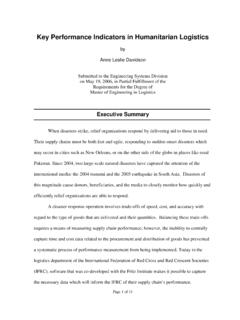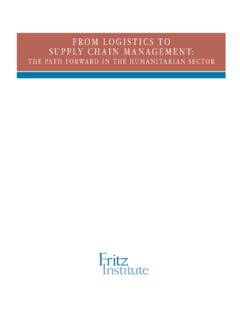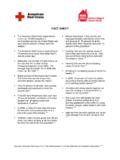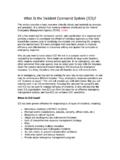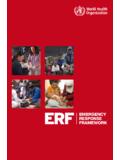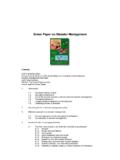Transcription of Jeannette Sutton and Kathleen Tierney Natural …
1 disaster preparedness : Concepts, guidance , and Research Jeannette Sutton and Kathleen Tierney Natural Hazards Center Institute of Behavioral Science University of Colorado Boulder, CO Report prepared for the Fritz Institute Assessing disaster preparedness Conference Sebastopol, California, November 3 and 4, 2006. Table of Contents 1 Organization of This 2 What is disaster preparedness ? .. 3 Elements and Dimensions of disaster preparedness .. 6 Hazard Knowledge: Hazard Identification and Risk, Impact, and Vulnerability 7 Management, Direction, and Coordination.
2 9 Formal and Informal Response Supportive Life Safety 11 Property 11 Emergency Coping and Restoration of Key Functions .. 11 Initiation of 12 Units of Analysis for disaster preparedness .. 12 Households .. 12 13 Communities and 13 preparedness Measures across Units of Analysis .. 14 Household preparedness .. 14 Research Instruments and guidance .. 15 Common Metrics Utilized in Surveys .. 15 Common Measures Suggested in preparedness guidance ..16 Business preparedness .. 18 Research Instruments and guidance .. 20 Common Metrics Used in Surveys .. 21 Common Measures Suggested in preparedness guidance .
3 23 Public Sector/Government Agency preparedness .. 24 Research Instruments and guidance .. 25 Common Metrics Used in Surveys .. 26 Common Measures Suggested in preparedness guidance ..27 General Principles of 31 Concluding Comments .. 37 38 Tables Table 1. preparedness Dimensions and Activities .. 8 Table 2. DHS Target Capabilities List .. 30 Appendices Appendix A Business Continuity Journal Scan Appendix B Business Journals Article Scan Appendix C Business Continuity Journals Appendix D Household preparedness Surveys Appendix E Household preparedness guidance and Checklists Appendix F Business preparedness Surveys Appendix G Business preparedness guidance and Checklists Appendix H Public Sector Surveys Appendix I Public Sectors preparedness guidance Appendix J Survey Instrument Descriptions disaster preparedness .
4 Concepts, guidance , and Research Introduction preparedness for disasters is critical for households, businesses, and communities, but many remain unprepared. As recent disasters serve to highlight the need for individual responsibility, local coordination, and continuity plans to ensure the ability to respond to and recover from major events, the federal government has prioritized national preparedness as a goal without developing a system to achieve and maintain it. Furthermore, public entities have been charged with assessing their state of readiness and identifying strengths and areas of weakness as a requirement for receiving federal funding and Homeland Security grants.
5 In response, some communities have chosen to utilize voluntary accreditation programs such as the Emergency Management Accreditation Program in order to assess their ability to respond to disaster while others have relied on internal resources. The end result is an inconsistent, non-standardized series of self-reports that may or may not reveal an entity s true state of disaster preparedness . In an effort to move toward the development of reliable, valid preparedness metrics, we provide a summary of the concepts, guidance , and research that informs an understanding of what it means to be prepared as a household, a business, and a community.
6 This research will be useful for groups responsible for public education campaigns, business continuity programs, and emergency responders, as well as those who have an interest in developing a standardized index to measure disaster preparedness . This report describes concepts and measures that social scientists and practitioners employ in assessing preparedness activities carried out by households, public agencies, private sector entities and communities. It also reviews key guidance on how to enhance preparedness efforts. The report is based on a systematic review of research instruments, preparedness guidance , and literature from a variety of sources, including archived research data, guidance from federal agencies, documents promoting best practices for preparedness in households, businesses, and communities, and the substantial scholarly literature that exists on preparedness and planning.
7 We also conducted a survey of business journals published in the past five years in order to assess the extent to which research-based guidance is available to business continuity professionals (see Appendix A and B for methods related to these scans; see Appendix C for a complete listing of the articles in each of the business continuity journals surveyed). In assessing surveys on preparedness practices, we used two major archives containing preparedness assessment surveys. The first archive, which was assembled by the UCLA Center for Public Health and Disasters, focuses on public preparedness for earthquakes in California; a second archival source included surveys that were conducted by the disaster Research Center at the University of Delaware and that focused on businesses and disasters.
8 In total we reviewed and compared items for 14 different surveys from these two sources (summaries of individual survey items, see Appendix J). 2 preparedness guidance reviewed for this report included documents from federal agencies such as the Department of Homeland Security (DHS) and the Federal Emergency Management Agency (FEMA), as well as non-governmental agencies and other organizations, including the American Red Cross (ARC), the Business Executives for National Security (BENS), the National Fire Protection Agency (NFPA), and the Emergency Management Accreditation Program (EMAP). Many of these documents contain checklists designed to provide guidance on recommended preparedness measures for households, businesses, and communities.
9 We analyzed the survey questions and preparedness guidance by looking for key themes and recommended preparedness measures, in order to identify preparedness goals (referred to here as dimensions) and activities associated with preparedness . Major dimensions of preparedness were sometimes explicitly discussed in guidance documents on preparedness . We used these dimensions to further categorize the activities that were included in the checklists and survey questions that focused on preparedness . The research instruments and the preparedness guidance used in this study are cataloged in the appendices of this document and are organized by unit of analysis that is, households, businesses, and communities.
10 Surveys are followed by guidance documents and are analyzed based upon dimensions and activities that appeared in the various documents surveyed. (See Appendices D-I.) Organization of This Report This report is organized into three sections. In the first section, we identify preparedness dimensions and activities that cross all three units of analysis. These broad descriptions serve as a framework to categorize the variety of activities commonly associated with disaster preparedness . Here we supply a number of definitions for preparedness and contrast preparedness with mitigation, in order to clarify overlapping borders of the two types of activities.
